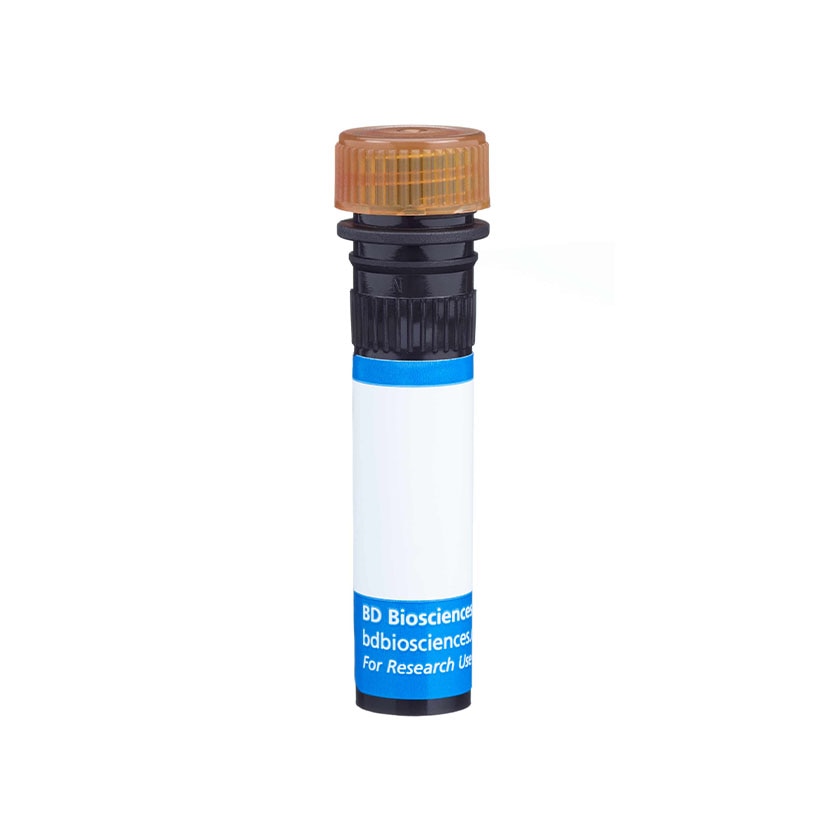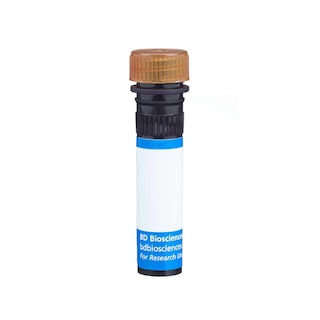Old Browser
Looks like you're visiting us from {countryName}.
Would you like to stay on the current country site or be switched to your country?




Two-color flow cytometric analysis of CD162 expression on mouse splenocytes. Mouse splenic leucocytes were preincubated with Purified Rat Anti-Mouse CD16/CD32 antibody (Mouse BD Fc Block™) (Cat. No. 553141/553142). The cells were then stained with APC Hamster Anti-Mouse CD3e antibody (Cat. No. 553066/561826) and either Rat IgG1, κ Isotype Control (Cat. No. 560537; Left Panel) or PerCP-Cy™5.5 Rat Anti-Mouse CD162 (Cat. No. 564310; Right Panel). Two-color flow cytometric dot plots showing the correlated expression of CD162 (or Ig Isotype control staining) versus CD3e were derived from gated events with the forward and side light-scatter characteristics of viable leucocytes. Flow cytometric analysis was performed using a BD™ LSR II Flow Cytometer System.


BD Pharmingen™ PerCP-Cy™5.5 Rat Anti-Mouse CD162

Regulatory Status Legend
Any use of products other than the permitted use without the express written authorization of Becton, Dickinson and Company is strictly prohibited.
Preparation And Storage
Product Notices
- Since applications vary, each investigator should titrate the reagent to obtain optimal results.
- An isotype control should be used at the same concentration as the antibody of interest.
- Caution: Sodium azide yields highly toxic hydrazoic acid under acidic conditions. Dilute azide compounds in running water before discarding to avoid accumulation of potentially explosive deposits in plumbing.
- Please observe the following precautions: Absorption of visible light can significantly alter the energy transfer occurring in any tandem fluorochrome conjugate; therefore, we recommend that special precautions be taken (such as wrapping vials, tubes, or racks in aluminum foil) to prevent exposure of conjugated reagents, including cells stained with those reagents, to room illumination.
- PerCP-Cy5.5–labelled antibodies can be used with FITC- and R-PE–labelled reagents in single-laser flow cytometers with no significant spectral overlap of PerCP-Cy5.5, FITC, and R-PE fluorescence.
- PerCP-Cy5.5 is optimized for use with a single argon ion laser emitting 488-nm light. Because of the broad absorption spectrum of the tandem fluorochrome, extra care must be taken when using dual-laser cytometers, which may directly excite both PerCP and Cy5.5™. We recommend the use of cross-beam compensation during data acquisition or software compensation during data analysis.
- For fluorochrome spectra and suitable instrument settings, please refer to our Multicolor Flow Cytometry web page at www.bdbiosciences.com/colors.
- Cy is a trademark of GE Healthcare.
- Please refer to www.bdbiosciences.com/us/s/resources for technical protocols.
Companion Products






The 2PH1 monoclonal antibody specifically binds to the N-terminus of CD162 (P-selectin glycoprotein ligand-1, PSGL-1), encoded by the Selplg gene. PSGL-1 is expressed on the cell surface as a homodimer of approximately 230 kDa. In the mouse, Selpl mRNA is detected in most tissues, with high levels found in hematopoietic cells, brain, and adipose tissue. Flow cytometric analyses have revealed CD162 expression on bone marrow-derived mast and dendritic cells, splenic leukocytes, platelets, peripheral blood neutrophils, and neutrophil and T-cell lines. PSGL-1 is a ligand for P-selectin (CD62P) and is involved in leukocyte rolling, the migration of leukocytes into inflamed tissues, and responses to vascular injury. It is a sialomucin that must be specifically sialylated, fucosylated, and sulfated to bind P-selectin. There is also evidence that other ligands for PSGL-1 and CD62P may exist. The 2PH1 antibody is reported to block binding of mouse leukocytes to CD62P, but the 4RA10 antibody (Cat. No. 557787) has significantly greater blocking activity.

Development References (11)
-
Borges E, Eytner R, Moll T, et al. The P-selectin glycoprotein ligand-1 is important for recruitment of neutrophils into inflamed mouse peritoneum. Blood. 1997; 90(5):1934-1942. (Immunogen: Blocking, ELISA, Flow cytometry, Immunoprecipitation, Inhibition, In vivo exacerbation). View Reference
-
Borges E, Tietz W, Steegmaier M, et al. P-selectin glycoprotein ligand-1 (PSGL-1) on T helper 1 but not on T helper 2 cells binds to P-selectin and supports migration into inflamed skin. J Exp Med. 1997; 185(3):573-578. (Biology). View Reference
-
Frenette PS, Denis CV, Weiss L, et al. P-Selectin glycoprotein ligand 1 (PSGL-1) is expressed on platelets and can mediate platelet-endothelial interactions in vivo. J Exp Med. 2000; 191(8):1413-1422. (Biology). View Reference
-
Hirata T, Furie BC, Furie B. P-, E-, and L-selectin mediate migration of activated CD8+ T lymphocytes into inflamed skin. J Immunol. 2002; 169(8):4307-4313. (Clone-specific: Flow cytometry). View Reference
-
Hirata T, Merrill-Skoloff G, Aab M, Yang J, Furie BC, Furie B. P-Selectin glycoprotein ligand 1 (PSGL-1) is a physiological ligand for E-selectin in mediating T helper 1 lymphocyte migration. J Exp Med. 2000; 192(11):1669-1675. (Biology). View Reference
-
Li F, Wilkins PP, Crawley S, Weinstein J, Cummings RD, McEver RP. Post-translational modifications of recombinant P-selectin glycoprotein ligand-1 required for binding to P- and E-selectin. J Biol Chem. 1996; 271(6):3255-3264. (Biology). View Reference
-
Pendl GG, Robert C, Steinert M, et al. Immature mouse dendritic cells enter inflamed tissue, a process that requires E- and P-selectin, but not P-selectin glycoprotein ligand 1. Blood. 2002; 99(3):946-956. (Clone-specific: Blocking, Flow cytometry, Immunoprecipitation). View Reference
-
Phillips JW, Barringhaus KG, Sanders JM, et al. Single injection of P-selectin or P-selectin glycoprotein ligand-1 monoclonal antibody blocks neointima formation after arterial injury in apolipoprotein E-deficient mice. Circulation. 2003; 107(17):2244-2249. (Biology). View Reference
-
Sperandio M, Smith ML, Forlow SB, et al. P-selectin glycoprotein ligand-1 mediates L-selectin-dependent leukocyte rolling in venules. J Exp Med. 2003; 197(10):1355-1363. (Clone-specific: Flow cytometry). View Reference
-
Steegmaier M, Blanks JE, Borges E, Vestweber D. P-selectin glycoprotein ligand-1 mediates rolling of mouse bone marrow-derived mast cells on P-selectin but not efficiently on E-selectin. Eur J Immunol. 1997; 27(6):1339-1345. (Biology). View Reference
-
Xia L, Sperandio M, Yago T, et al. P-selectin glycoprotein ligand-1-deficient mice have impaired leukocyte tethering to E-selectin under flow. J Clin Invest. 2002; 109(7):939-950. (Clone-specific: Flow cytometry). View Reference
Please refer to Support Documents for Quality Certificates
Global - Refer to manufacturer's instructions for use and related User Manuals and Technical data sheets before using this products as described
Comparisons, where applicable, are made against older BD Technology, manual methods or are general performance claims. Comparisons are not made against non-BD technologies, unless otherwise noted.
For Research Use Only. Not for use in diagnostic or therapeutic procedures.
Report a Site Issue
This form is intended to help us improve our website experience. For other support, please visit our Contact Us page.